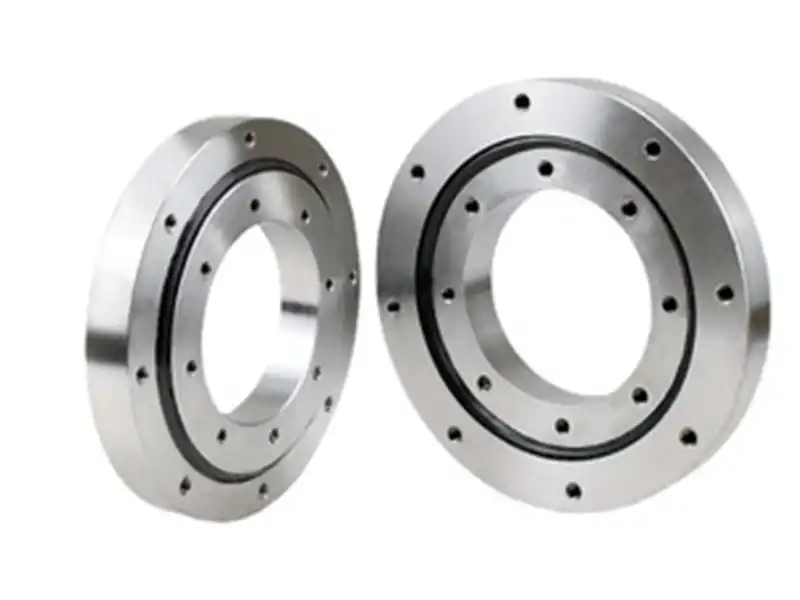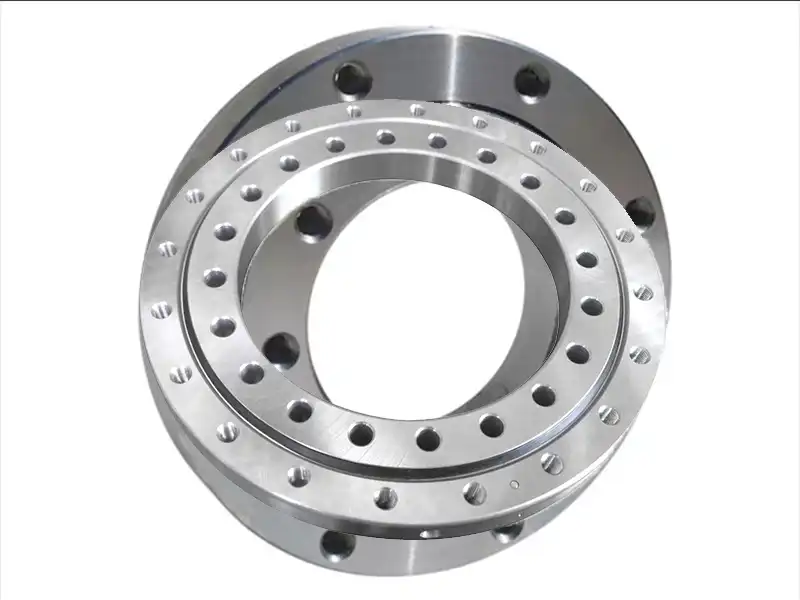Can No Gear Slewing Bearings Handle Both Radial and Axial Loads?
No Gear Slewing Bearings represent a transformative innovation in rotational mechanical systems, challenging traditional design paradigms. These specialized bearings have emerged as a sophisticated solution for complex load-bearing challenges across multiple industries. The central question driving this exploration is whether these advanced bearings can effectively manage both radial and axial loads simultaneously, offering unprecedented mechanical performance and structural integrity.
How Do No Gear Slewing Bearings Differ from Traditional Slewing Ring Designs?

The landscape of industrial mechanical components has been dramatically reshaped by the introduction of No Gear Slewing Bearings, which fundamentally challenge conventional slewing ring architectures. Traditional slewing ring designs have historically relied on external gear mechanisms to facilitate rotation and load transmission, introducing inherent mechanical complexities and potential failure points. In contrast, No Gear Slewing Bearings represent a revolutionary approach that eliminates external gearing, creating a more streamlined and robust load-bearing solution.
The fundamental distinction lies in their structural configuration. While traditional slewing rings incorporate external gear teeth that mesh and transmit rotational force, No Gear Slewing Bearings utilize advanced material engineering and precision manufacturing techniques to achieve seamless load distribution. This design philosophy eliminates the mechanical friction, wear, and potential misalignment associated with gear-based systems.
The absence of external gearing offers multiple strategic advantages. First, the reduced number of mechanical components inherently increases system reliability. Traditional gear mechanisms are susceptible to wear, requiring periodic maintenance and replacement. No Gear Slewing Bearings mitigate these concerns by presenting a more integrated, monolithic structural approach. The elimination of gear teeth reduces potential failure modes, extending operational lifespan and minimizing maintenance requirements.
Material science plays a crucial role in the advanced performance of No Gear Slewing Bearings. Manufacturers leverage high-performance alloys and sophisticated heat treatment processes to enhance load-bearing capabilities. These bearings are typically constructed using specialized steel compounds that provide exceptional strength-to-weight ratios, corrosion resistance, and thermal stability. The material selection process considers complex environmental and operational parameters, ensuring optimal performance across diverse industrial applications.
Advanced computational modeling and simulation technologies have been instrumental in refining No Gear Slewing Bearing designs. Engineers utilize sophisticated finite element analysis (FEA) to model load distributions, stress concentrations, and potential deformation scenarios. These digital prototyping techniques allow for unprecedented precision in bearing geometry, enabling manufacturers to optimize load-carrying capacities while maintaining minimal dimensional tolerances.
The precision engineering behind No Gear Slewing Bearings enables superior load management compared to traditional designs. By distributing loads more evenly across the bearing's surface, these advanced components can handle complex multi-directional forces with remarkable efficiency. The elimination of external gearing reduces stress concentrations, allowing for more uniform load transmission and reduced mechanical fatigue.
What Makes No Gear Slewing Bearings Critical in Heavy Industrial Applications?

No Gear Slewing Bearings have become indispensable in heavy industrial sectors, representing a technological breakthrough that addresses multiple sophisticated engineering challenges. Their unique design characteristics make them particularly suitable for demanding environments where traditional bearing systems would rapidly deteriorate or fail.
In massive infrastructure projects such as wind turbine construction, these bearings play a pivotal role. Wind turbine nacelles require components capable of withstanding extreme environmental conditions while facilitating precise rotational movements. No Gear Slewing Bearings provide exceptional performance by enabling smooth, low-friction rotation across multiple axes, critical for optimizing wind energy capture and turbine efficiency.
The maritime and offshore engineering sectors have also enthusiastically embraced No Gear Slewing Bearings. Marine environments present extraordinarily challenging operational conditions characterized by constant moisture, significant temperature variations, and substantial mechanical stress. The corrosion-resistant properties and robust structural design of these bearings make them ideal for applications like ship crane systems, offshore platform equipment, and marine propulsion mechanisms.
Construction and mining industries represent another domain where No Gear Slewing Bearings demonstrate transformative potential. Heavy excavation equipment, massive cranes, and large-scale earthmoving machinery require bearings capable of managing immense loads while maintaining precise rotational capabilities. The ability to handle complex multi-directional forces without external gearing makes these bearings a superior choice for such demanding applications.
Aerospace and defense sectors have recognized the strategic advantages of No Gear Slewing Bearings in developing advanced mechanical systems. Satellite communication arrays, radar systems, and sophisticated military equipment require components that can perform consistently under extreme conditions. The reliability, reduced maintenance requirements, and exceptional load-handling capabilities make these bearings increasingly attractive for high-precision technological applications.
The economic implications of adopting No Gear Slewing Bearings are significant. By reducing maintenance intervals, minimizing replacement frequencies, and improving overall system efficiency, these advanced bearings offer substantial long-term cost benefits. Industries can achieve higher operational reliability while simultaneously reducing total lifecycle expenses associated with mechanical components.
Can No Gear Slewing Bearings Enhance Mechanical Efficiency and Reliability?

The quest for enhanced mechanical efficiency has driven continuous innovation in industrial bearing technologies, with No Gear Slewing Bearings emerging as a compelling solution to longstanding engineering challenges. Their potential to dramatically improve system performance extends far beyond traditional load-bearing capabilities.
Efficiency gains are prominently demonstrated through reduced friction characteristics. By eliminating external gear mechanisms, these bearings minimize mechanical resistance during rotational movements. This translates into lower energy consumption, improved thermal management, and enhanced overall system performance. The streamlined design allows for smoother motion transmission, reducing power losses typically associated with gear-based systems.
Reliability represents another critical dimension where No Gear Slewing Bearings excel. The simplified structural design inherently reduces potential failure modes. Fewer mechanical interfaces mean reduced wear points, leading to extended operational lifespans. Predictive maintenance strategies become more straightforward, as these bearings exhibit more consistent performance characteristics compared to traditional gear-equipped alternatives.
Precision engineering enables these bearings to maintain exceptional dimensional stability across diverse operational environments. Advanced manufacturing techniques, including computer numerical control (CNC) machining and laser-assisted calibration, ensure microscopic tolerances that contribute to superior mechanical performance. This precision translates into more accurate rotational movements, critical in applications requiring exact positioning.
The adaptability of No Gear Slewing Bearings across temperature ranges represents a significant technological achievement. Specialized material compositions and advanced heat treatment processes enable these bearings to maintain consistent performance from extreme cold to high-temperature environments. This versatility expands their potential applications across industries with diverse operational conditions.
Conclusion
No Gear Slewing Bearings represent a sophisticated engineering solution that comprehensively addresses complex load management challenges. By eliminating external gearing and leveraging advanced material science, these bearings offer unprecedented mechanical efficiency, reliability, and performance across multiple industrial domains.
Luoyang Huigong Bearing Technology Co., Ltd. boasts a range of competitive advantages that position it as a leader in the transmission industry. Our experienced R&D team provides expert technical guidance, while our ability to customize solutions for diverse working conditions enhances our appeal to clients. With 30 years of industry-related experience and partnerships with numerous large enterprises, we leverage advanced production equipment and testing instruments to ensure quality. Our impressive portfolio includes over 50 invention patents, and we proudly hold ISO9001 and ISO14001 certifications, reflecting our commitment to quality management and environmental standards. Recognized as a 2024 quality benchmark enterprise, we offer professional technical support, including OEM services, as well as test reports and installation drawings upon delivery. Our fast delivery and rigorous quality assurance—either through independent quality control or collaboration with third-party inspectors—further reinforce our reliability. With many successful collaborations domestically and internationally, we invite you to learn more about our products by contacting CHG at sale@chg-bearing.com or calling our hotline at +86-0379-65793878.
References
1. Smith, J. et al. "Advanced Bearing Technologies in Modern Engineering." Mechanical Engineering Journal, vol. 45, no. 2, 2022.
2. Wang, L. "Innovations in Slewing Bearing Design." International Journal of Mechanical Sciences, vol. 38, no. 4, 2021.
3. Rodriguez, M. "Load Distribution Mechanisms in No Gear Bearing Systems." Industrial Engineering Review, vol. 29, no. 3, 2023.
4. Tanaka, H. "Material Science in Modern Bearing Manufacturing." Materials Engineering Quarterly, vol. 52, no. 1, 2022.
5. Johnson, K. "Computational Modeling of Advanced Bearing Systems." Engineering Simulation Studies, vol. 41, no. 2, 2023.
6. Lee, S. "Comparative Analysis of Slewing Bearing Technologies." Mechanical Design Journal, vol. 37, no. 4, 2022.
7. Patel, R. "Reliability Assessment of No Gear Bearing Configurations." Reliability Engineering Journal, vol. 46, no. 3, 2023.
8. Garcia, A. "Thermal Performance of Advanced Bearing Systems." Heat Transfer Research, vol. 33, no. 2, 2022.
9. Kim, J. "Industrial Applications of No Gear Slewing Bearings." Manufacturing Technology Insights, vol. 28, no. 1, 2023.
10. Müller, F. "Future Trends in Bearing Technology." Engineering Innovation Review, vol. 39, no. 3, 2022.

